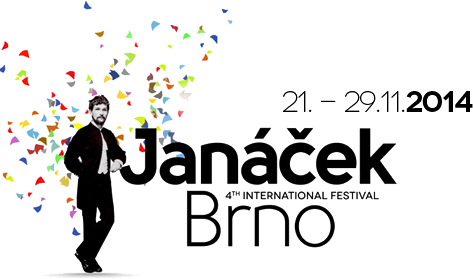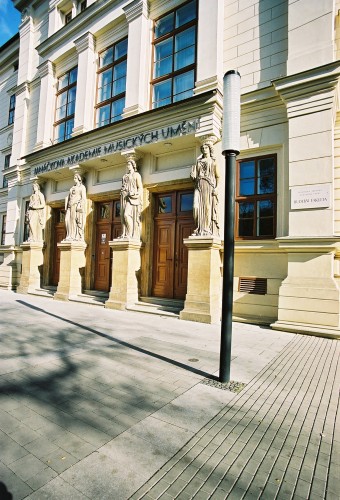A presentation from selected departments of MF JAMU connected to the festival’s dramaturgical themes
Bohuslav Martinů: Suite from Ballet Kitchen Revue
Prolog (Allegretto-Marche)
Tango (Lento)
Charleston (Poco a poco Allegro)
Final (Tempo di Marcia)
Conductor: doc. Vít Spilka
Clarinet: Lukáš Dittrich
Bassoon: Klaudie Jurmanová
Trumpet: Miloš Macháň
Violin: Jan Rybka
Violoncello: Lukáš Svoboda
Piano: Tereza Plešáková
Erwin Schulhoff: Step
Edgard Varèse: Ionisation
Department of Percussion Instruments of doc. Martin Opršál
LEOŠ JANÁČEK (1854–1928)
Moravian Folk Poetry in Song
Love Letter
Doubt
Little Feather
Little Bench
A Lover’s Radiance
Constancy
A Lover’s Picture
The Mayor’s Daughter
Fidelity
Who’s the flower for?
Featuring: Jana Jelínková, Irina Shevchuk, Jana Vondrů, Tadeáš Hoza.
JAN NOVÁK (1921–1984)
Three Inventions
Allegro
Andante
Vivace
Violin: Barbora Kozáková
Violin: Karel Svačina
Viola: Jitka Svačinová
Cello: Petr Osička
Scenario and staging of project: Zuzana Fischerová
Students of HF JAMU are participating in the project
The Janáček Academy of Music and Performing Arts has a reputation as an institute which trains top-class interpreters of classical music. However, to prevent this description from being taken too seriously, JAMU decided to give Maestro Janáček a slightly more humorous “musical gift” for his 160th birthday. The Seriously Unserious Exhibition is the musical equivalent of a museum exhibition. For those who are interested, it offers musical “exhibits” which are made special by the unconventional surroundings and atmosphere of the whole event.
The opening of the musical “exhibition” takes place at the assembly hall of JAMU’s Music Faculty and the first “musical exhibit” will be the suite from the ballet The Kitchen Revue by Bohuslav Martinů (1890–1959), the most important Czech composer of the 20th century after Janáček. The thirty-seven-year-old composer wrote the Kitchen Revue ballet when he was living in Paris and was intoxicated, almost consumed, by the jazz which was coming to Europe from the American continent. The Kitchen Revue was written at Easter 1927 and was first performed in the same year at Prague’s Rudolfinum by the J Kröschlová ballet ensemble (Kröschlová being the author of the scenario). Paradoxically, the ballet suite enjoyed more popularity than the original ballet version. Even though the suite is an abridged version and contains only four of the original ten parts, the selection naturally contains all the musical gems. The opening Prologue (Allegretto – Marche) switches to the slow Tango (Lento), magically paraphrasing Ravel’s famous Bolero, which is followed by the rhythmically stirring Charleston (Poco a poco allegro), and the suite comes to a close with a strident march Finale (Tempo di marcia).
Further “musical exhibits” will be located in parts of the Music Faculty’s premises which are not normally used for public performances. These exhibits are variable, so our audience members are kindly asked to read the following paragraphs in the order appropriate to the situation at the time.
The vaulted hall in the newly reconstructed underground space of the Music Faculty is practically unknown to the public. It is the home of the teachers and students of percussion instruments, who will perform works by two composers who were contemporaries of Leoš Janáček. Like Martinů, the Czech composer of German-Jewish origin Erwin Schulhoff (1894–1942) had been captivated by jazz for a long time. It was one of his most expressive compositional tools and was characteristic of his earlier work. Jazz also influenced his graceful Suite for Chamber Orchestra from 1921, one part of which was entitled Step. This short, rhythmically expressive work has a special status in the six parts of the suite as it was written solely for percussion instruments.
The Frenchman Edgard Varèse (1883–1965) spent most of his life in the USA. In his work he focused on the sound characteristics of music, which he developed by using new instruments, varying their location within the environment, and so on. This approach was a breakthrough in the way music was understood at the time. The composition Ionisation from 1931 was written for 13 percussionists and 37 instruments in total (two sirens and a piano that the composer used as a percussion instrument). Working with different rhythmic variations represents the ionization of molecules, which gives the composition its name.
The classroom space on the first floor was built as a miniature stage, and because of its room number it became known as Nine. Here students work on their theatre projects. As part of the Musical Exhibition there will be “song exhibits” from the workshop of Leoš Janáček (1854–1928), which present him as a lover of folk song. The collection Moravian Folk Poetry in Song reflects the composer’s passion for collecting folk melodies from the forgotten corners of the globe, which the composer wanted to preserve for future generations.
The Musical Exhibition also offers listeners an unconventional performance by a string quartet in the open area of JAMU’s staircase. Here you can listen to Three Inventions by Jan Novák (1921–1984), one of the most prominent composers in Brno in the second half of the 20th century. Apart from Vítězslava Kaprálová, Jan Novák was the only student of Bohuslav Martinů who consciously emulated him in his composition. The Latin language was of fundamental importance for the composer’s compositional style. Novák studied Latin, translated into Latin, wrote his own poetry and composed instrumental music based on its meter. The Three Inventions for String Quartet were most likely written between 1960 and 1968. The composition is made up of three independent movements (Allegro – Andante – Vivace), which are partially linked by the use of characteristic intervals of seconds and thirds.
Monika Holá







